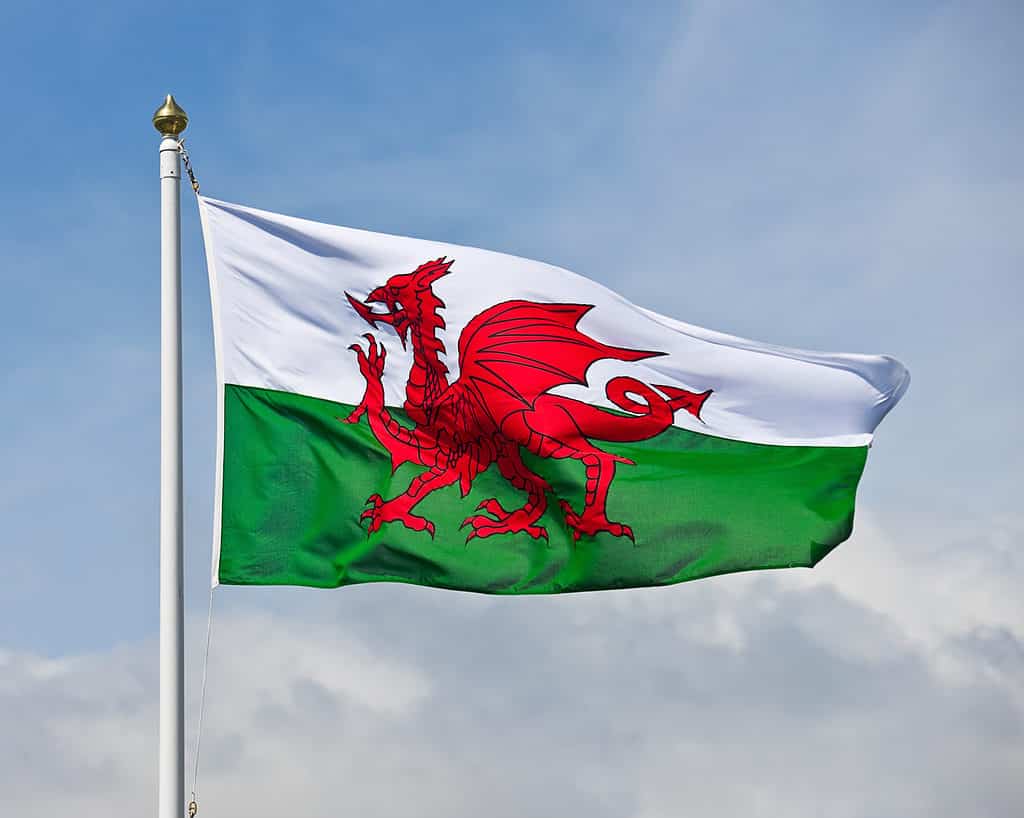The island of Great Britain and the various countries within it can often be confusing to understand. Each country in the UK has a long history that is unique to itself, and their flags often reflect this. In the case of Wales, their national flag may have one of the most notable designs and histories. Today, we are going to explore the flag of Wales, including its history, meaning, and symbolism!
The Flag of Wales: Appearance

The Welsh flag displays a red dragon turned sideways on a field of white and green.
©Jane McIlroy/Shutterstock.com
The flag of Wales is also called the Welsh flag, Baner Cymru, and the Y Ddraig Goch. It is easily one of the most recognizable flags in the world. The design is simple, yet clearly influenced by the history of the country and the mythology surrounding it.
The Welsh flag displays a red dragon turned sideways on a field of white and green. The red dragon is in a common position known as “passant”. It is facing left and seems to be walking.
Two colors make up the background. The top half of the flag is white, while the bottom of the flag is green. The entire flag has a ratio of 3:5, which is the most common aspect ratio for national flags.
The Flag of Wales: History and Symbolism
Wales is an old country in the United Kingdom and has had a strong national identity since the Middle Ages. The heraldry customs of its past have influenced the flag, making it extremely unique and rooted in history.
The Welsh Dragon

The oldest official record of the “Welsh dragon” dates back to 828 A.D.
©malgosia janicka/Shutterstock.com
The origins of the dragon are unknown, although some historians believe it stems from the Romans. The Roman cavalry in the 2nd and 4th centuries carried the “Draco standard”, on which sat a dragon or serpent.
The oldest official record of the “Welsh dragon” dates back to 828 and is written in the Historia Brittonum. The Historia Brittonum is a document detailing the history of the British people. Although the oldest surviving examples date to the 11th century, the originals likely came from a few hundred years earlier. This document states the dragon is red in color and a sign of independence.
Many historians believe the dragon represents delivery from their oppressors, the Saxons. Dating as far back as 655 A.D., a white dragon represented the Saxons. Similarly, the Welsh took a red dragon as their icon. Later depictions of the struggle between the Welsh and the Saxons depict two dragons, one red and one white.
The Green and White Field
The country didn’t add the green and white background until quite a bit later. In 1485, Henry Tudor flew the red dragon as he invaded England, eventually uniting the country and taking the throne. Officials placed the red dragon he carried on the Tudor livery colors, which were green and white.
The Flag of Wales: Modern Standing
The red dragon and the green and white colors give us a clear understanding of how the modern flag evolved. There have been a few iterations of the flag throughout history, although they are all somewhat similar.
In 1807, officials placed the dragon on a green mount and used it as the Royal Badge of Wales. This symbol is still recognized today. The words on the badge read, “The red dragon leads the way”. A short time after, they used the badge to create the Welsh flag. However, it was eventually replaced because the tail of the dragon along with the inscription incidentally referenced a bull’s penis.
In 1959, the country updated the flag to the current design.
Up Next:
- The Flag of the United States of America: History, Meaning, and Symbolism
- The Flag of Thailand: History, Meaning, and Symbolism
- The Flag of Switzerland: History, Meaning, and Symbolism
The photo featured at the top of this post is © JMiks/Shutterstock.com
Thank you for reading! Have some feedback for us? Contact the AZ Animals editorial team.







